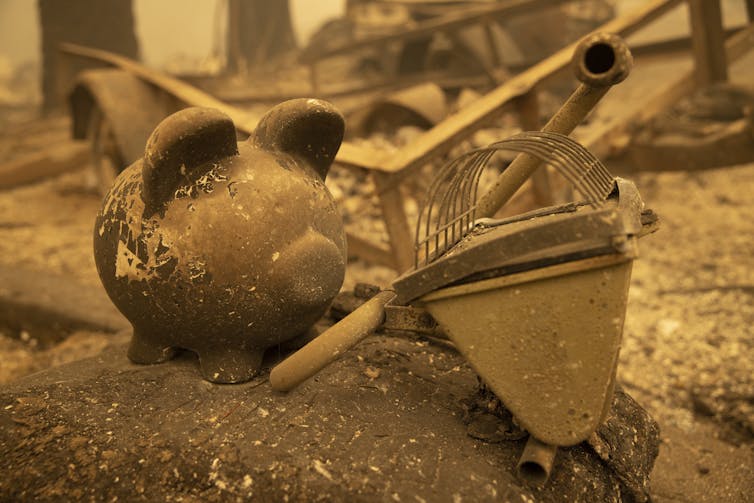Super funds are feeling the financial heat from climate change
- Written by Amandine Denis, Head of Research, ClimateWorks Australia, Monash University

The wild fires that have ravaged the US west coast, turning skies orange, are a lurid reminder that climate change looms ever larger as an economic threat.
This week has seen a flurry of announcements reflecting that reality.
Read more: Coping with Western wildfires: 5 essential reads[1]
New Zealand’s government has declared it will become the world’s first country to require its financial sector to report on climate risks.
A collaboration between Australian banks, insurers and climate scientists – the Climate Measurement Standards Initiative[2] – has issued the nation’s first comprehensive framework to assess climate-related risks to buildings and critical infrastructure.
And another of Australia’s largest superannuation funds, UniSuper, has committed to achieving net zero carbon emissions[3] from its investment portfolio by 2050.
UniSuper, the industry fund for university workers, is the third major Australian super fund to make such a commitment.
Read more: UniSuper take note: there's no retirement on a dead planet[4]
The first was HESTA, the industry super fund for health and community sector workers, in June[5]. The second was CBus, the construction and mining industry super fund, last month. “The reality is that things are coalescing fast around us,” said Kristian Fok[6], CBus’ chief investment officer at the time.
While the superannuation industry remains very much in transition, analysis by ClimateWorks Australia[7] and the Monash Sustainable Development Institute indicates a new determination among Australia’s 20 largest Registrable Superannuation Entity licensees to act on climate change risks.
These 20 licensees represent about 55% of all superannuation investments in Australia, worth a total of about A$2.7 trillion.
Along with the 2050 commitments by HESTA, CBus and UniSuper, another 13 funds are actively looking to reduce their portfolio’s emissions intensity. For example, Aware Super (formerly First State Super) announced in July it would divest from thermal coal miners and reduce emissions in its listed equities portfolio by at least 30% by 2023.
Only four of the 20 – Colonial First State, IOOF, Nulis and OnePath – still have no emissions reduction targets or activities.
Managing risk
This flurry of announcements reflects a changing context.
In the past, fund managers sometimes argued that, in a heavily regulated industry, their legal responsibilities prevented them from committing to emissions reductions. They were tasked, they said, with protecting their members’ finances, not guarding the environment.
Until about 2017, super funds tended to limit action to asking companies in which they owned shares to disclose their climate risks and to offering voluntary sustainable investment options to their members.
But since the Paris climate agreement in 2015, targets of net zero emissions by 2050 (or earlier) have been adopted by governments, businesses and investors. More than 100 countries and all Australian states and territories have net zero targets in place. So do some major companies, such as BHP and Qantas.
Many businesses now recognise the financial implications of global warming. ANZ, for example, this month announced it expected the 100 biggest-emitting customers to have a plan to adapt to a low-carbon economy – something the bank’s chief executive, Shayne Elliot, said was simply “good old-fashioned risk management[8]”.
This accords with the perspective of regulators, with Australian Prudential Regulation Authority regarding global warming not as a moral issue but one “distinctly financial in nature[9]”.
 Climate change is now an issue ‘distinctly financial in nature’. Peter Dasilva/EPA
Climate change is now an issue ‘distinctly financial in nature’. Peter Dasilva/EPA
This means asset managers are increasingly thinking about how more frequent and extreme weather events will devalue property and infrastructure. They are also thinking about the future worth of companies rusted to fossil fuels as the global economy shifts to net zero emissions.
Investors must also consider the possibility of litigation. For example, 24-year-old Brisbane council worker Mark McVeigh has taken the Retail Employees Superannuation Trust to court on the basis it has failed to protect his savings from the financial consequences of ruinous climate change.
Creating the new normal
Understandably, many funds are hesitant to commit to net zero emission portfolio targets without knowing how those targets might be achieved.
But by setting targets, super funds can create a norm that spurs investment in the ways and means to achieve those goals.
With the manifestations of that warming becoming ever more apparent, pressure will grow on super funds to make net zero pledges across their entire portfolios – and then to back these pledges with both interim commitments and detailed transition strategies.
Read more: California is on fire. From across the Pacific, Australians watch on and buckle up[10]
As Kristian Fok says, change is coalescing fast. We’re seeing promising signs of the super funds responding. But we’ll need to see more yet.
References
- ^ Coping with Western wildfires: 5 essential reads (theconversation.com)
- ^ Climate Measurement Standards Initiative (www.cmsi.org.au)
- ^ achieving net zero carbon emissions (www.unisuper.com.au)
- ^ UniSuper take note: there's no retirement on a dead planet (theconversation.com)
- ^ in June (www.hesta.com.au)
- ^ said Kristian Fok (www.theguardian.com)
- ^ ClimateWorks Australia (www.climateworksaustralia.org)
- ^ good old-fashioned risk management (www.afr.com)
- ^ distinctly financial in nature (www.afr.com)
- ^ California is on fire. From across the Pacific, Australians watch on and buckle up (theconversation.com)
Authors: Amandine Denis, Head of Research, ClimateWorks Australia, Monash University
Read more https://theconversation.com/super-funds-are-feeling-the-financial-heat-from-climate-change-146191














